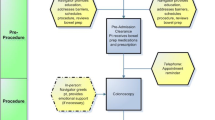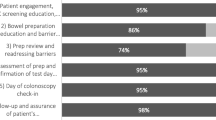Abstract
Colorectal cancer (CRC) is the second leading cause of cancer-related deaths in the United States. Racial disparities in CRC incidence and mortality have been well documented. In addition, lower rates of CRC screening among ethnic minorities have been reported. Therefore, we tested the effectiveness of a patient navigator (PN) in increasing compliance with CRC screening in a minority community health setting. Men and women aged 50 or older attending a primary care practice were enrolled if they had not had a fecal occult blood test within the past year, a sigmoidoscopy or barium enema within the past 3–5 years, or a colonoscopy within the past 10 years. Participants were randomly assigned either to receive navigator services (PN+) or not to receive navigator services (PN−). There were no demographic differences between the two groups. Within 6 months of physician recommendation, 15.8% in the PN+ group had complied with an endoscopic examination, compared with only 5% in the PN− group (P=.019). The PN+ groups also demonstrated higher rates of fecal occult blood test completion (42.1% vs. 25%, P=.086). Thus, a PN system successfully increases CRC screening rates among a predominantly minority population of low socioeconomic status.
Similar content being viewed by others
References
Greenlee RT, Hill-Harmonn MB, Murray T, Thun M. Cancer statistics, 2001 CA Cancer J Clin. 2001;51:15–36.
Jemal A, Murray T, Samuels A, Ghafoor A, Ward E, Thun MJ. Cancer statistics, 2003. CA Cancer J Clin. 2003;53:5–26.
Cancer Prevention and Control. Comparison of use of colorectal cancer tests with other cancer screening tests, NHIS 2000. Available at: http:/www.cdc.gov/cancer/colorctl/calltoaction/slides_index.htm (slide35). Accessed April 11, 2005.
National Cancer Institute. SEER cancer statistics review 1973–1997. Available at: http://seer.cancer.gov/csr/1973_1997/colorect.pdf. Accessed April 5, 2005.
Behavioral Risk Factor Surveillance System. Technical information and data. Available at: http://www.cdc.gov/brfss/technical_infodata/surveydata/1997.htm. Accessed April 5, 2005.
Mandel JS, Bond JH, Church TR, et al. Reducing mortality from colorectal cancer by screening for fecal occult blood. Minnesota Colon Cancer Control Study. N Engl J Med. 1993;328:1365–1371.
Mandel JS, Church TR, Bond JH et al. The effect of fecal occult-blood screening on the incidence of colorectal cancer. N Engl J Med. 2000;343:1603–1607.
Hardcastle JD, Chamberlain JO, Robinson MH, et al. Randomised controlled trial of faecaloccult-blood screening for colorectal cancer. Lancet. 1996;348:1472–1477.
Burt RW. Colon cancer screening. Gastroenterology. 2000;119:837–853.
Newcomb PA, Norfleet RG, Storer E, Surawicz TS, Marcus PM. Screening sigmoidoscopy and colorectal cancer mortality. J Natl Cancer Inst. 1992;84:1572–1575.
Selby JV, Friedman GD, Quesenberry CP Jr, Weiss NS. A case-control study of screening sigmoidoscopy and mortality from colorectal cancer. N Engl J Med. 1992;326:653–702.
Tingen MS, Weinrich SP, Heydt DD, Boyd MD, Weinrich MC. Perceived benefits: a predictor of participation in prostate cancer screening. Cancer Nurs. 1998;21:349–357.
Frelix GD, Rosenblatt R, Solomon M, Vikram B. Breast cancer screening in underserved women in the Bronx. J Natl Med Assoc. 1999;91:195–200.
Freeman HP, Muth BJ, Kerner JF. Expanding access to cancer screening and clinical follow-up among the medically underserved. Cancer Pract. 1995;3:19–30.
Gauthier MA, Clarke WP. Gaining and sustaining minority participation in longitudinal research projects. Alzheimer Dis Assoc Disord. 1999;13:S29-S33.
Stoy DB, Curtis RC, Dameworth KS, et al. The successful recruitment of elderly black subjects in a clinical trial: the CRISP experience. Cholesterol Reduction in Seniors Program. J Natl Med Assoc. 1995;87:280–287.
Author information
Authors and Affiliations
Corresponding author
Rights and permissions
About this article
Cite this article
Jandorf, L., Gutierrez, Y., Lopez, J. et al. Use of a patient navigator to increase colorectal cancer screening in an urban neighborhood health clinic. J Urban Health 82, 216–224 (2005). https://doi.org/10.1093/jurban/jti046
Published:
Issue Date:
DOI: https://doi.org/10.1093/jurban/jti046




